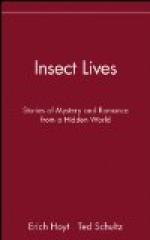From the prominence of imaginal structures in the pupa, it is at once seen that the pupa of any insect must resemble the adult more nearly than it resembles the larva. But in different groups of insects we find different degrees of likeness between pupa and imago. In a beetle pupa (see fig. 16 c), the appendages—feelers, jaws, legs, wings—stand out from the body as do those of the perfect insect. This type is called a free pupa. The pupal cuticle has to be shed for the emergence of the imago, but the pupa is already a somewhat reduced model of the final instar, with abbreviated wings and doubled-up legs. A free pupa is characteristic of the Coleoptera, Neuroptera, Trichoptera, Hymenoptera and many Diptera. In some cases the pupa requires to be specially adapted for a peculiar mode of life; for example, a special arrangement of breathing organs may be necessary for life under water, and there must needs be temporary pupal structures, not represented in the imago.
On the other hand, in the pupae of most Lepidoptera and of some Diptera, there is more or less coalescence between the cuticle of the appendages and the cuticle of the body generally, so that the appendages do not stand out, but being, as it were, glued down to the body, are somewhat masked (see fig. 1 e and fig. 23). Consequently the obtect pupa, as this type is called, does not resemble its imago as fully as a free pupa does. The outline of the wings for example in a butterfly’s pupa can in some cases be traced only with difficulty. T.A. Chapman has shown (1893) that the completely obtect pupa characterises the more highly developed families of Lepidoptera, while in the more primitive families the pupa is incompletely obtect. If the pupa of a butterfly or moth be lifted and held in the hand, a bending or wriggling motion of the abdomen can be observed. In the incompletely obtect pupa, this motion is evident in a greater number of segments than in the completely obtect, the number concerned varying from five to two in different families. In the nymphalid butterflies, the pupa is often called a ‘chrysalis’ on account of the golden hue displayed by the cuticle, and the term ‘chrysalis’ is sometimes bestowed indiscriminately on any kind of pupa. It has been shown by Poulton (1892) and others, that the colour of a butterfly pupa is to some extent affected by the surroundings of the caterpillar just before its last moult.
Reference has been made (p. 58) to the power of spinning silk possessed by many larvae; often the principal use of this silk is to form some protection for the pupa, the larva before its last moult constructing a cocoon within which the pupa may rest safely. Many larvae bury themselves in the earth, and the pupa lies in an earthen chamber, the lining particles of soil fastened together by fine silken threads. Larvae that feed in wood, like the caterpillar of the Goat-moth (Cossus) make a cocoon of splinters spun




